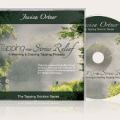To help you better understand why our brains are hard-wired for stress, I’ve pulled out Chapter 2 of my book, “The Tapping Solution for Manifesting Your Greatest Self”, for you to read. Enjoy!
Day 2 – Negativity, Hardwired: A Look at the Primitive Brain
Grog and Thor sit perched at the edge of their cave.
You know Grog, your great-great-great-great-great-great-great-ancestor. You’d recognize him; you both have the same nose. He’s waiting patiently but alertly with his friend Thor. They’ve been hearing some saber-toothed tiger sounds, not too far from their lovely abode.
Grog says, “Ughr all ogg ogg ralf woomr.” Oh, you don’t speak caveman? I’ll translate for you the rest of the way.
“I’m pretty nervous about that tiger. It sounds like a big one, and it’s coming our way.”
Thor, twiddling his thumbs, half meditating in a lotus position, says, “Brotherman, there is nothing to worry about! The sun is shining, we’ve discovered fire and some basic tools, and this cave is luxurious. Bask in gratitude and the joy of life!”
Grog looks around nervously. It sounds like the tiger is getting closer, and quickly.
“Thor, I’m going to higher ground. We’re tiger meat in this spot, and I don’t think the two of us are going to be able to handle this guy.”
“Grog, you are so negative! Always talking about what could go wrong, always ‘moving to higher ground’ or worrying about this or that. You know, you’re just not going to attract what you want in your life with that attitude!”
Sensing the tiger’s approach, Grog scampers away at a full sprint toward higher ground, where the tiger can’t climb. He makes one last desperate call to Thor, “Please! Run!”
Thor continues his peaceful meditation.
And is swallowed almost whole by one of the largest saber-toothed tigers to roam the ancient world.
Well, at least Thor seemed happy until his untimely death.
Grog lives, and with him, his DNA. And partly because of his negative, pessimistic, cautious attitude, he survives.
Thor has vanished, along with his “happy” genes.
And so it goes, again and again and again and again . . .
And thus, the human brain evolved, literally clinging for dear life to something we call the “negativity bias.”
Your Brain’s Primitive Panic Button
Yesterday we looked at peace and panic, and we began using tapping to have a new experience.
Ever wondered why we even need to do that? Why there always seems to be something — or several things — standing between us and happiness, us and peace, us and fulfillment, and so on.
Why is it so much easier to choose panic over peace?
Sometimes it seems like our “default” setting is to be negative and fearful… and that’s because in large part it is.
For our own protection—cue Grog and the “negativity bias” that saved his life — the brain evolved to assume the worst. It’s biased toward negativity. In his book Hardwiring Happiness, Rick Hanson, Ph.D., explains this concept in more detail:
Our ancestors could make two kinds of mistakes:
(1) thinking there was a tiger in the bushes when there wasn’t one, and
(2) thinking there was no tiger in the bushes when there actually was one.The cost of the first mistake was needless anxiety, while the cost of the second one was death.
Consequently, we evolved to make the first mistake a thousand times to avoid making the second mistake even once…
In general, the default setting of the brain is to overestimate threats, underestimate opportunities, and underestimate resources both for coping with threats and for fulfilling opportunities. Then we update these beliefs with information that confirms them, while ignoring or rejecting information that doesn’t. There are even regions in the amygdala, which an almond-shaped part of the mid-brain that’s intricately connected to the body’s “stress response” that’s specifically designed to prevent the unlearning of fear, especially from childhood experiences. As a result, we end up preoccupied by threats that are actually smaller or more manageable than we’d feared, while overlooking opportunities that are actually greater than we’d hoped for. In effect, we’ve got a brain that’s prone to “paper tiger paranoia.”
Most of us can recognize this experience in our daily lives. We get an e-mail or text that feels unclear, whether in meaning or tone. Immediately, we go to the negative. Or we get a call, and someone says something vague like, “Hey, do you have a minute? We need to talk.”
For most of us, it takes only a second or two to assume the worst. Without thinking, our brains translate “we need to talk” into “something’s wrong.” Similarly, rather than noticing that the text message we just received is unclear, we default to the negative—deciding, for instance, that it’s hurtful or insulting.
We then feel fearful, angry, sad—any number of negative emotions that reinforce our need to defend ourselves from (yet another) attack. Before we’ve even considered that the person may have been in a rush and carelessly worded the text message, we’re ready to retreat and/or attack him in return.
And because of how our brains have evolved, this process is so automatic that we often don’t even recognize when it’s happening.
When you really think about that, it’s pretty extreme. It’s also the reality of the human brain, which defaults to a negative lens so powerful that it easily and quickly taints our entire experience.
Tricky, Sneaky, and Subversive, Too
Sometimes the “negativity bias” is even subtler and harder to notice. For example, in the off-kilter morning I shared in Day 1, my negativity bias might look like me deciding that I can’t control my mornings, even if I don’t love how they feel.
Oftentimes we brush off these decisions casually.
“What are you gonna do?” we ask.
“It’s just life,” we say as we return to our to-do lists.
While it’s true that we often have limited control of the external world around us, these reactions can, at times, support us in lowering our expectations.
In tiny ways we don’t consciously recognize, we then give the brain’s negativity bias room to thrive.
Best-selling author Brené Brown sums it up this way: “We think if we can beat vulnerability to the punch by imagining loss, we’ll suffer less.”
We see this tendency to focus on negative experiences more than positive ones in research studies, as well. The psychologist Daniel Kahneman received the Nobel Prize in economics for showing that most people will do more to avoid a loss than to benefit from an equivalent gain. In intimate relationships, we typically need at least five positive interactions to counterbalance every negative one. And for people to begin to thrive in life, they usually need positive moments to outweigh negative ones by at least a three-to-one ratio.
I would argue that these numbers might be even larger than the research suggests. I know that one negative review of my books on Amazon can easily overwhelm 100 positive reviews — if I don’t tap on it, that is!
For people to begin to thrive in life, they usually need positive moments to outweigh negative ones by at least a three-to-one ratio.
So how can we reverse this “negativity bias” in the simple everyday ways that allow our greatest selves, and then our greatest lives, to emerge?
It starts with cultivating simple awareness about how those three pounds of gray matter that you’re carrying around (aka your brain) actually work. Just being aware of your brain’s negativity bias is a huge first step in overcoming it.
That basic understanding encourages us to view positivity as a practice rather than an attribute or a personality trait.
Being positive then becomes a skill we can consciously choose to hone every day.
Day 2 Greatest Self Challenge: Redirecting Your Brain
So how do we actually bring positivity practice into our lives?
On a day-to-day, week-to-week basis, how can we reprogram our brains to recognize and accept positivity without becoming so detached from our surroundings that, like Thor, we’re prematurely devoured?
Start by simply noticing when you default to the negative.
Start with the little things, like that e-mail or text that feels unclear. Your brain’s natural bias will lead you to assume the worst. Your brain’s innate negativity bias will support you in feeling judged, accused, and so on.
Starting today, make a point of simply noticing when your brain’s “negativity bias” is being activated.
Remember, it’s a hardwired response that we all experience, so there’s no need to blame or shame yourself for it. Don’t stress or worry about it. Just notice it.
And once you see your brain’s negativity bias at work, pause and ask yourself: Could this be my brain’s negativity bias talking?
That’s it — just notice it, for now, say hello, maybe introduce yourself, and we’ll use that awareness to build from in the coming days.
Make sure to take time to use the Day 2 Tapping Meditation: Turning toward the Positive to begin reorienting your primitive brain to notice and value the positive. (I’ve included a link to the transcript for now so that you can already start using it)
Day 2 Tapping Meditation: Turning Toward the Positive
You’re beginning to create an important foundation for choosing peace!











Connect With Us on Social Media